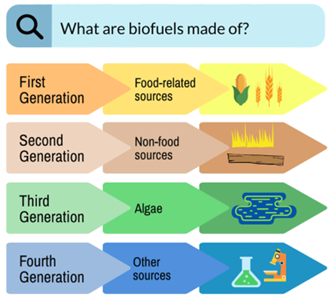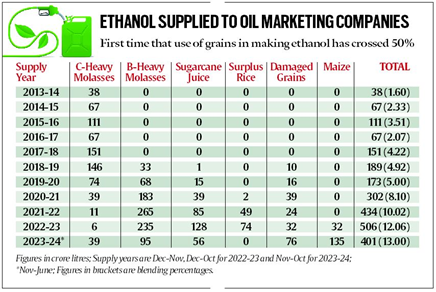Why in the News?
In the current supply year, from November 2023 to October 2024, sugar mills and distilleries provided 401 crore litres of ethanol to oil marketing companies by June 30.
Of this total, 211 crore litres (52.7%) were produced using maize and damaged food grains (primarily broken or old rice unfit for human consumption).
The remaining 190 crore litres were derived from sugarcane-based feedstocks, including molasses and whole juice/syrup.
What’s in Today’s Article?
- About Biofuel (Definition, Purpose, Types of Biofuels)
- Ethanol Blending (Meaning, how it is done, Blending in India)
- News Summary (Reasons Behind Positive Change)
About Biofuel:
- Biofuel is a fuel that is produced over a short time span from biomass, rather than by the very slow natural processes involved in the formation of fossil fuels, such as oil.
- Since biomass can be used as a fuel directly (e.g., wood logs), some people use the words biomass and biofuel interchangeably.
- However, the word biofuel is usually reserved for liquid or gaseous fuels, used for transportation.
- Most of biofuel consumption occurs as a blend with refined petroleum products such as gasoline, diesel fuel, heating oil, and kerosene-type jet fuel.
- However, some biofuels do not require blending with their petroleum counterparts and are referred to as drop-in biofuels.
- The most common biofuels now are:
- Bioalcohols such as ethanol, propanol, and butanol (a substitute for petrol/gasoline);
- Biodiesel (a substitute for diesel);
- Bio-oils (substitutes for kerosene).
Generations of Biofuel:

What is Ethanol Blending?
- Ethanol is a biofuel, naturally produced by the fermentation of sugars by yeasts or by petrochemical processes like ethylene hydration.
- Ethanol is high in oxygen content, allowing an engine to more thoroughly combust fuel.
- In ethanol blending, a blended motor fuel containing ethyl alcohol derived from agricultural products is blended with petrol specifically.
How is Ethanol Produced?
- In India, the nodal department for the promotion of fuel-grade ethanol-producing distilleries is the Department of Food and Public Distribution (DFPD).
- Ethanol is produced or procured from sugarcane-based raw materials which are – C & B heavy molasses, sugarcane juice, sugar syrup, surplus rice with Food Corporation of India (FCI) and maize.
- A paper released by the NITI Aayog stated, that in 2019, over 110 billion liters of ethanol fuel was produced globally.
- The US and Brazil account for 84% of the global production followed by the European Union, China, India, Canada and Thailand.
What are the Benefits of Ethanol Blending?
- Presently, India imports over 85 per cent of its oil requirement and ethanol blending could help in reducing dependency on petroleum.
- In 2020-21, the net import of petroleum in India was 185 million tones at USD 551 billion.
- Thus, ethanol blending can help in saving billions of dollars for the country and reduce import dependency.
- Also, ethanol is a less polluting fuel and equally efficient at a lower cost than petrol.
India’s Biofuel Policy:
- In 2021-22, the Central government amended the Biofuel Policy (2018) to set a target of country-wide blending rates of 20% ethanol and 5% biodiesel by 2025.
- According to the Roadmap for ethanol blending in India 2020-2025 report from NITI Aayog, India will need to increase ethanol production capacity from the expected 3.3 billion liters (in 2020–2021) to at least 10.2 billion liters (5.5 billion liters from sugarcane and 4.7 billion liters from grains) by 2025.
Ethanol Used In Petrol Now More From Maize, Damaged Foodgrains Than Sugar:
- During the current supply year (November 2023 to October 2024), sugar mills and distilleries have supplied 401 crore litres of ethanol to oil marketing companies up to June 30.
- Of this total, 211 crore litres, or 52.7%, were produced using maize and damaged foodgrains (primarily broken or old rice unsuitable for human consumption).
- The remaining 190 crore litres were derived from sugarcane-based feedstocks, including molasses and whole juice/syrup.
- This is the first time that the contribution of grains to India’s ethanol production has surpassed 50% — from 27.1% in 2022-23, 16.7% in 2021-22, 13.6% in 2020-21, 9.2% in 2019-20, 5% in 2018-19 and zero in 2017-18.

Reasons Behind this Positive Change:
- Until 2017-18, ethanol production in India was limited to C-heavy molasses, a sugar industry byproduct.
- The Ethanol Blended Petrol (EBP) program expanded in 2018-19 under the current government, allowing production from B-heavy molasses and whole cane juice/syrup, with mills receiving higher prices to offset reduced sugar production.
- The program further diversified when mills began using grains like surplus and damaged rice from the Food Corporation of India (FCI).
- From July 2023, the government stopped supplying FCI rice and restricted the use of cane juice and B-heavy molasses due to concerns over cereal and sugar inflation.
- Consequently, maize has become the primary ethanol feedstock, incentivized by a higher ex-distillery price of Rs 71.86 per litre.
- The EBP program now uses multiple feedstocks to meet ethanol demand, benefiting maize farmers in states like Karnataka and Bihar.
- However, poultry and livestock feed industries report a domestic maize shortage, with production at 36 million tonnes against a requirement of 41 million tonnes.
- The government has allowed 0.5 million tonnes of maize imports at a 15% concessional duty, but the industry seeks up to 5 million tonnes of imports at zero duty.










